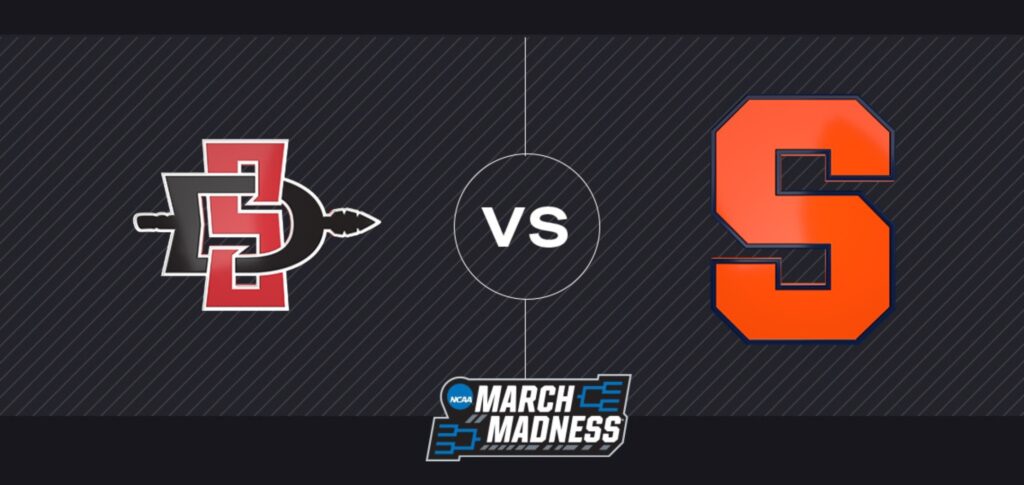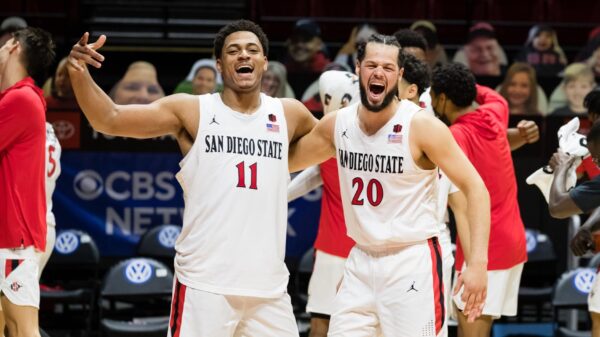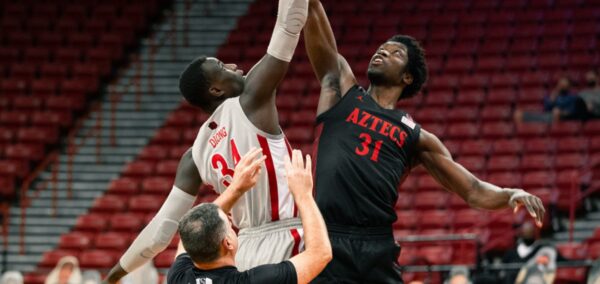Three keys to an Aztecs win over Syracuse

NCAA Logos

#6 San Diego State Aztecs vs. #11 Syracuse Orange
Friday, March 19, 2021
Tip Time: 6:40 PM
TV: CBS
As he received the MVP trophy of the last week’s Mountain West Conference Tournament, Matt Mitchell was asked what the win meant to him and his team. His response was indicative of the selfless nature of the 2020-2021 Aztecs, as he spoke about being happy for Joshua Tomaic and Terrell Gomez because they left other programs for the chance to win with SDSU in March. Further punctuating the significance of Gomez’s and Tomaic’s opportunity is the realization that three seniors last season made a similar move to the Mesa, but never got the opportunity to experience the Madness of March.
“Oh! Definitely.” Matt Mitchell responded when asked if he has been in contact with Yanni Wetzell, KJ Faegin, and Malachi Flynn, “I’ve been talking to those guys the past couple of weeks just about the energy leading up to the conference tournament and the NCAA Tournament – about the energy we need to have and the energy we’re bringing especially since the guys returning didn’t get this chance last year. Now, we are playing for each other, playing for this team. At the same time, we’re playing for the guys that weren’t able to play last year, and showing out for them as well.”
Syracuse is the more storied program in Friday’s matchup. It is the household name. Reputation is likely the main reason for the Selection Committee’s puzzling inclusion of the Orange- who have resembled an NIT team this season- in this year’s tournament. San Diego State is the better team in Friday’s matchup, not only this season but in the past few years. To avoid an upset, SDSU needs to focus on these three keys to victory.
1. The chess match with Syracuse’s 2-3 zone
The most talked-about aspect of SDSU’s matchup with Syracuse is the 2-3 zone Syracuse plays, and for a good reason. It is iconic and synonymous with the Orange. Terrific articles have been written about the best ways to attack the zone, yet not enough attention has been given to the different looks Syracuse can give out of the zone.
In a game against Clemson, Syracuse’s 2-3 zone looked more like a 4 – 1 with the wing players creeping up to stop the jump shooters on both sides of the arc. Other times, the zone looks more like a 1-3-1 with a guard sagging more towards the free-throw line along with the wings creeping up. Still other times, the defense has matchup elements with the center of the defense sprinting out to contest threes in the corner, for instance.
The defense is designed to create one of two outcomes: force a particular player to shoot or force deep, contested threes late in the shot clock. It can vary greatly – even in one game – to adapt to the strength of the offense, but typically, the Orange are adept enough at running it. They only require subtle tweaks on game day. How quickly SDSU recognizes the changing holes in the zone and exploits them is the first key to victory.
“Obviously, we shoot the ball at a high level,” coach Dutcher said, “so they’ll try and take that away. They’ll take certain shooters away and extend the defense to that player or two, and then, we have to attack off the bounce or inside. All of a sudden, if we’re not making jump shots, then, they’ll pack it back in. It’ll be an adjustment for both teams.”
2. Nathan Mensah and Joshua Tomaic
If there is one glaring advantage for SDSU, it is size down low. Syracuse is not a deep team, and their frontline is led by 6′ 10″, 201-pound senior Marek Dolejaz. He plays the center of the 2-3 zone. Offensively, he is not a threat from the three-point line. The Aztecs need Nathan Mensah and Joshua Tomaic to use their size advantage to open up lanes on the offensive end. On defense, SDSU will likely switch all ball screens, so the duo is going to be called up to guard Syracuse’s perimeter players.

Throughout the season, when Mensah has a good game, Tomaic does not. Conversely, when Mensah is struggling, Tomaic steps up and performs well. Mensah has scored 15 or more points four times this season. In those games, Tomaic averages a little more than two points a game. There have been a couple of times when both played well in the same game, most notably in the finals of the Mountain West Tournament against Utah State.
For all the talk about the 2-3 zone, the simplest strategy for beating it involves deep post catches by SDSU’s centers. If Dolejaz is unable to handle Mensah and Tomaic on the block, Syracuse will be forced to tighten their zone and leave tons of space for SDSU’s shooters. Likewise, the play of SDSU’s centers when the Aztec guards penetrate is important. Whether it is moving to the open gaps in the defense, finishing on lobs, or simply taking up space in effective ways, the Aztecs’ big men need to capitalize on their size advantage.
Syracuse has good size everywhere else except at the center position. They run a lot of isolation with backside movement. Mensah and Tomaic anchoring the defensive front and turning the Orange into jump shooters is the best recipe for success – even if Syracuse is capable of knocking down jumpers. A dominant performance on both ends of the floor by Mensah and Tomaic should continue the Aztecs’ dance into March.
3. Containing Quincy Guerrier
Games in March usually come down to a few baskets. Five or fewer points have decided six of the last eight #6 vs. #11 matchups. Scoring in the half-court when the defense is set up is the most difficult way to score, so whichever team can score easy baskets on Friday will likely move on to the next round.
[wpedon id=”49075″ align=”right”]
There are many players on SDSU who could score these easy buckets. They have numerous players who can grab offensive rebounds. Many players can push the pace to score in transition off a missed basket. SDSU’s elite defense is also responsible for creating a couple of opportunities in a game for instant offense.
Syracuse’s path to easy baskets is more limited. Getting into transition on long rebounds from three or from ill-advised passes is one path. Outside of that, on paper, all other options involve one player: Quincy Guerrier.
Guerrier is the Orange’s third-leading scorer and leading rebounding. He is the only consistent offensive rebounder on their team. A sophomore at 6’7” 220 pounds from Montreal, Canada, Guerrier is the only rotation player who can match up with SDSU’s physicality. If the Aztecs can minimize Guerrier’s impact on the game, while matching the rest of Orange’s intensity, they should be able to limit Syracuse’s easy basket while maximizing their own.
“(Guerrier) is a high-energy, physical guy,” Matt Mitchell said, “I watched his film – Crashing the offensive boards, catching the ball in the mid-post, and he does shoot the ball from three a little bit. He likes to take that shot. He’s a very physical guy. He’s a strong, burly guy. Kind of chiseled, and just goes in there and muscles his way in.”
My earliest sport’s memory involve tailgating at the Murph, running down the circular exit ramps, and seeing the Padres, Chargers and Aztecs play. As a second generation Aztec, I am passionate about all things SDSU. Other interests include raising my four children, being a great husband and teaching high school.